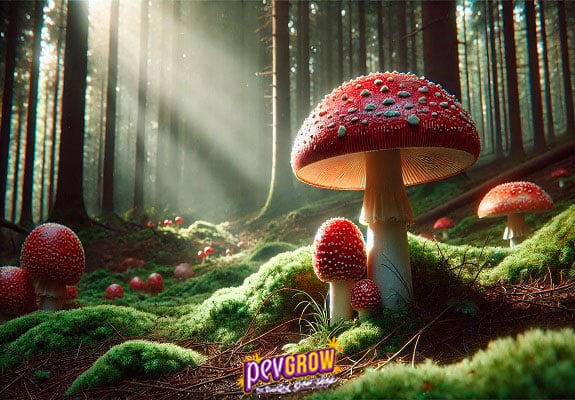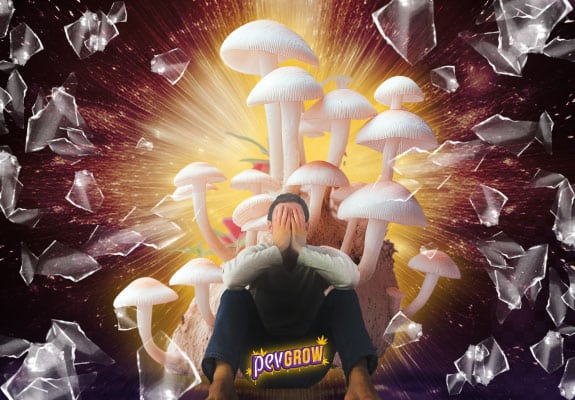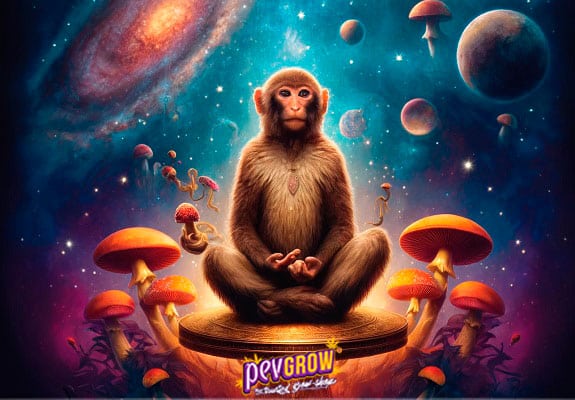

12-09-2024 06:50:38 - Updated: 12 September, 2024
The Amanita muscaria, also known as the fly agaric, is one of the most iconic and recognizable magic mushrooms in the mycological world. With its vibrant red cap adorned with white spots, it has been immortalized in tales, legends, and mythologies throughout history. This mushroom is not only fascinating for its visual appearance but also for its potent psychoactive properties that have made it a fungus surrounded by mystery and culture. From shamanic rituals to theories about its connection to Norse myths, the Amanita muscaria remains a subject of study and admiration worldwide. In this article, we delve into the characteristics, consumption, effects, and curiosities of this extraordinary mushroom, and how it has left its mark on human history.
📌 Amanita muscaria parts and characteristics
The Amanita muscaria is a mushroom recognized for its striking appearance and psychoactive effects. Below are its main characteristics:
Physical Characteristics:
- Cap: The cap of the Amanita muscaria is bright red and covered with small white spots that are remnants of the volva. It can measure between 8 and 20 cm in diameter. In some variants, the cap may have yellow or orange tones.
- Stem: The stem is white, tall, and robust, with a prominent ring at its top. The base of the stem has a volva (sack-like structure), which is also white.
- Gills: Under the cap, it has white gills that are not attached to the stem.
- Spores: Its spores are white and elliptical in shape.
Active Components:
Muscimol and ibotenic acid: These are the main psychoactive compounds of the Amanita muscaria. Ibotenic acid converts to muscimol when the mushroom is dehydrated or cooked, reducing its toxicity.
Amanita Muscaria Family
The Amanita muscaria belongs to the Amanitaceae family, which includes a wide number of mushrooms, many of which are known to be poisonous or highly toxic. This family is characterized by having species that present distinctive structures such as the cap, stem with a ring, and volva at the base, traits that are also present in the Amanita muscaria.
🌞 Types of Amanita Muscaria
The Amanita muscaria has several subspecies and varieties that differ slightly in appearance, although they share similar characteristics in terms of structure and toxicity. Below are some of the main types of Amanita muscaria:
-
Amanita muscaria var. muscaria
This is the most common variety and is the one most people associate with the Amanita muscaria. It is characterized by its bright red cap with white spots. It is native to Europe and North America and is the most recognized in popular culture.
-
Amanita muscaria var. formosa
Also known as the Amanita muscaria guessowii or yellow variety, it is primarily found in North America. This variety has a yellow or orange cap instead of the typical red, but still has the same characteristic white spots.
-
Amanita muscaria var. alba
This is a rare variety of Amanita muscaria with a white cap instead of red or yellow. Although less common, it also has the typical white spots of the species and is highly toxic.
-
Amanita muscaria var. regalis
This variety is known as the royal Amanita. It has a brown or golden-brown cap instead of red. It is common in the Nordic regions of Europe, especially in Scandinavia and Russia.
-
Amanita muscaria var. flavivolvata
This variety is primarily found in Central and North America, especially in Mexico. Its cap is a darker red tone, with a yellowish base on the stem.
Each of these varieties maintains the toxic and hallucinogenic properties typical of the Amanita muscaria, but they vary in color and geographical distribution.
🥀 Amanita Muscaria Effects
The Amanita muscaria is known for its psychoactive effects due to two main compounds: muscimol and ibotenic acid. These compounds affect the central nervous system, producing a range of sensations that can vary in intensity depending on the dose and preparation.
Common Effects of Amanita muscaria
- Euphoria: Many people report a feeling of intense well-being or happiness.
- Hallucinations: This is one of the most notable effects, which can include visual, auditory, and sensory distortions. The hallucinations are usually milder and different from those caused by mushrooms containing psilocybin.
- Alteration of time and space perception: Users may experience the sensation that time slows down or that the space around them distorts.
- Sedation: Often, after the euphoric or hallucinatory phase, consumers may feel extremely tired or sedated, which can lead to a state similar to sleep.
- Nausea and vomiting: It is common for some people to experience gastrointestinal discomfort, especially if consumed in high doses or if the mushroom has not been properly prepared.
- Confusion and disorientation: Due to the effects on the mind, individuals may feel confusion and difficulty maintaining a sense of reality.
- Muscle relaxation: Muscimol can produce a relaxing effect on the muscles, contributing to the sensation of sedation.
Duration of Effects
The effects can begin between 30 minutes and 2 hours after ingestion, depending on the amount consumed and the method of preparation. The full duration of effects can extend for 6 to 8 hours, although the subsequent sedation may last longer.
It is important to remember that the Amanita muscaria can be toxic in high doses, and its consumption should be done with great caution due to the variability in the concentration of its active compounds.
👾 Is it poisonous?
Yes, the Amanita muscaria is considered poisonous, although its toxicity is not usually lethal to humans in most cases. The toxicity of this mushroom is due to the presence of compounds such as ibotenic acid and muscimol, which affect the central nervous system and can cause hallucinations, nausea, vomiting, confusion, and in more severe cases, seizures or coma.
However, severe intoxications from Amanita muscaria are rare, as symptoms usually include gastrointestinal discomfort and extreme sedation before reaching a dangerous level. Most deaths associated with mushrooms of the Amanita genus are due to other species, such as Amanita phalloides, which is much more lethal.
It is crucial to prepare this mushroom properly if it is to be consumed, as the dehydration process can reduce some of the toxic compounds. Still, its use should be done with extreme caution, due to the possibility of variations in the concentration of its toxins.
✨ How to consume Amanita Muscaria?
Consumption of Amanita muscaria should be done with extreme caution due to its toxicity. Although some cultures have used it traditionally, it is essential to understand the risks and the safest methods to reduce its adverse effects. Below, I explain how it is usually prepared and consumed more safely:
Preparation
- Dehydration: The most common method to reduce the toxicity of Amanita muscaria is to dehydrate it. Dehydration at moderate temperatures (around 70°C) transforms some of the ibotenic acid into muscimol, which is less toxic and responsible for the psychoactive effects. This process reduces negative effects such as nausea and vomiting.
- Infusion or tea: After dehydrating the mushrooms, some people choose to make tea. For this, they are soaked in hot water (not boiling) for about 20-30 minutes. The tea extracts the active compounds but decreases the concentration of toxins.
- Microdosing: Given the risk of toxicity, many users opt for microdoses, meaning small amounts (usually less than 1 gram of dehydrated mushroom), which allow experiencing some benefits without reaching dangerous levels of intoxication.
Dose
The safe dose can vary widely depending on factors such as preparation, individual sensitivity, and the concentration of active compounds in the mushrooms, which can fluctuate significantly. Generally, small doses (less than 5 grams of dry mushroom) are considered safer, but it is important to start with very small doses if one is inexperienced.
Precautions
- Avoid high doses: Large doses (more than 10 grams of dry mushroom) can cause severe symptoms of intoxication, including disorientation, vomiting, and in extreme cases, seizures or coma.
- Consult an expert: Given the risk, it is advisable to consult experts or guides who are well-versed in the use of this mushroom.
🔰 Curiosities about this fly agaric
The Amanita muscaria, besides its striking appearance and psychoactive properties, has several curiosities that make it a fascinating fungus. Below are some of the most notable:
- Inspires the image of mushrooms in popular culture: The iconic appearance of the Amanita muscaria, with its red cap and white spots, has been the basis for the representation of mushrooms in movies, video games (like Super Mario Bros.), books, and fairy tales.
- Relationship with Siberian reindeer: In some Siberian cultures, shamans consumed Amanita muscaria during rituals to enter trance states. Reindeer, common animals in the region, also consume these mushrooms and have been observed to exhibit altered behaviors, leading to the theory that ancient shamans observed this phenomenon and imitated it.
- Possible origin of the Santa Claus myth: There are theories suggesting that the figure of Santa Claus may have been influenced by the relationship of Amanita muscaria with Siberian shamans. Santa’s red and white suit could reference the colors of this mushroom, and the flying reindeer could be related to the hallucinogenic effects observed in animals after consuming it.
- Used as an insecticide: One of the common names for Amanita muscaria, “fly agaric,” comes from its use in ancient times as an insecticide. It was soaked in milk, and the resulting liquid was used to attract and eliminate flies.
- Its effects vary depending on preparation: Although it can be toxic if consumed raw, dehydrating Amanita muscaria reduces its toxicity by transforming ibotenic acid into muscimol. This process minimizes side effects such as nausea and vomiting, allowing only the psychoactive effects to be experienced.
⚠️ Where is it found?
The Amanita muscaria is found in a wide variety of habitats in the northern hemisphere, mainly in coniferous and deciduous forests. This mushroom grows in mycorrhizal symbiosis with trees such as birches, pines, oaks, and firs, so it is common to find it in acidic soils, near the roots of these trees.
Regions where it can be found:
- Europe: It is common in forests throughout the continent, especially in Nordic and mountainous countries.
- North America: It is widely distributed in Canada, the United States, and Mexico, in wooded and mountainous regions.
- Asia: It is especially abundant in Siberia and other northern areas of Asia, where it has been traditionally used by shamans.
- Australia and New Zealand: Although not native to these regions, it was introduced and is now common in wooded areas of these countries.
Season
The Amanita muscaria appears mainly in autumn, when humidity conditions are more favorable for its growth. However, in some regions, it can also be found in spring.
📲 Conclusion and Final Reflection
The Amanita muscaria is much more than a mushroom with a striking appearance; it is a gateway to various traditions, stories, and scientific studies. Throughout the centuries, this mushroom has been used in rituals, represented in myths, and studied for its psychoactive effects and potential therapeutic uses. Although fascinating, its toxicity makes it a fungus that must be treated with extreme care and respect. By exploring its history and properties, it is crucial to remember that nature, while mysterious and full of potential, requires responsible management. The Amanita muscaria remains a symbol of the unknown, a reminder of the fine line between the beneficial and the dangerous in the world of mushrooms.
🌿 Frequently asked questions related to Amanita Muscaria
Is amanita muscaria edible?
The Amanita muscaria is not considered edible in its natural state due to its toxicity. It contains psychoactive compounds such as muscimol and ibotenic acid, which can cause a variety of effects, from hallucinations and disorientation to vomiting and gastrointestinal discomfort.
Consumption with caution
In some cultures, it has been consumed dehydrated to reduce toxicity, as the drying process converts ibotenic acid into muscimol, which is less toxic. Still, this mushroom should be treated with great care, and in general, its consumption as food is not recommended due to the risk of poisoning.
Risks
Intoxication from Amanita muscaria can cause severe symptoms such as nausea, vomiting, diarrhea, mental confusion, and even loss of consciousness in some cases. High doses can be dangerous, so its intake should be avoided unless under the supervision of experts and with a deep understanding of proper preparation. Therefore, although it has been traditionally consumed on some occasions, it is not considered a common or safe edible mushroom.
Is amanita muscaria legal?
The Amanita muscaria has a legal status that varies significantly by country, as it is not classified in the same way as other hallucinogenic mushrooms containing psilocybin, such as “magic mushrooms.” Below is its legal situation in different regions:
Legality in different countries:
United States: The Amanita muscaria is not classified as a controlled substance at the federal level, meaning it is legal in many states. However, its sale for human consumption may be regulated in some places.
Europe:
- In countries like Spain and France, it is not specifically regulated, which technically makes it legal, but its use for human consumption is not permitted or is restricted.
- In the United Kingdom, the sale and possession of Amanita muscaria are legal, although it is not approved for human consumption.
Australia and New Zealand: In Australia, the Amanita muscaria is classified as a controlled substance, making it illegal in most states. In New Zealand, it is allowed as long as it is not used for recreational purposes.
Canada: It is not listed as a controlled substance, so it is legal, although its sale for human consumption is not regulated.





After reading the article, I am clear that the amanita muscaria is fascinating but dangerous, and I definitely would not consume it without thoroughly informing myself first.